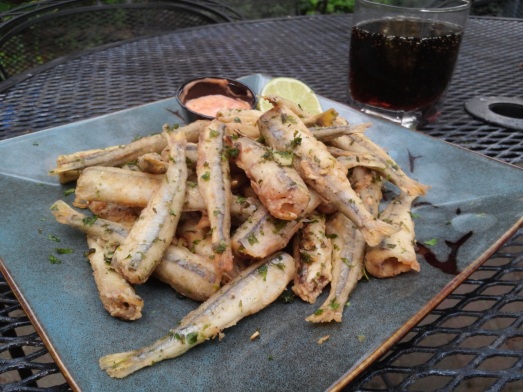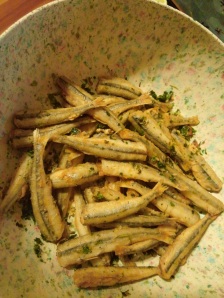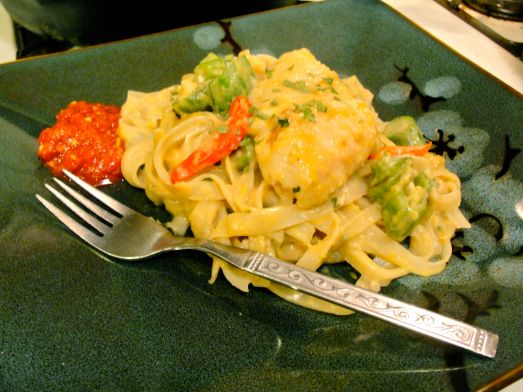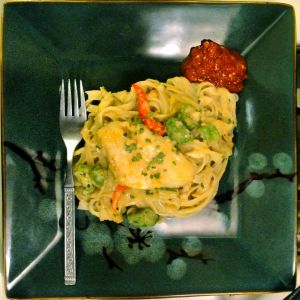
Fried Bluegill with zucchini green salad and sautéed chard
I haven’t posted many “rustic” meals. However, here’s one tied to my fond memories from summers at the lake in my childhood.
When I was young, my dad would fry panfish on the grill. First, of course, we’d have to catch the fish; typically for the lake we visit those would be perch, bluegill, and crappie (the latter two being varieties of sunfish.) Then he would clean them, stationed on an old wooden bench covered with newspaper; if there happened to be many perch in the catch, he was not happy… apparently they’re harder to clean. Next he would drop them in flour and fry them in cast iron pans on a charcoal grill, so as not to make a mess of the kitchen. My dad passed away more than half-my-life ago, but I still have these good memories and the cast iron pans as well. :)
I spent these past few days on a splendid holiday vacation at the lake in the northwoods (out of mobile phone coverage) with lots of swimming, canoeing, and just a bit of fishing. While in recent decades I’ve eschewed fishing, opting instead for even lazier passtimes at the lake, a recent interest in foraging and finding one’s own food, and the idea of preparing a meal one might be able to do solely from what the earth provides directly, helped to change that.

Bluegill, a common variety of freshwater Sunfish
Bluegill are an attractive, colorful variety of panfish, i.e., a fish that typically fits, whole, in a frying pan. (That’s a bit gruesome… wouldn’t that mean human beings could be called “pine box apes?”)
My companion and I caught four bluegill for this dinner, two for each of us; one was caught by casting an artificial lure and the others simply with cheese dangling on a hook as bait. I’ll admit I caught one and she caught three. :-) (When I was a kid, we usually fished with live bait: worms or night crawlers, but the cheese was conveniently on hand.) I don’t believe that bluegill have any special affinity for cheese, but they were more interested in it than hot dog. :) Sometimes you can even catch panfish on a bare hook!
I considered cooking the bluegill whole (sans scales and guts, of course), but decided to do it as my dad did, removing the fish’s head and its gills along with it.

Scaling the fish with a knife…Warning to the squeamish: fish guts!
Once cleaned, I simply patted the rinsed fish partially dry, and dipped them in flour, spiced with salt, pepper, fresh thyme leaves, and an adobo seasoning mix (from Penzey’s.)

Bluegill dipped in flour and seasonings
I poured perhaps 1/2 inch of canola oil into a cast iron pan on a medium heat grill. Once the oil was hot (test with a small piece of batter or food), I placed all four bluegill in the pan and cooked for 3-5 minute per side, until they began to brown and the fish flaked easily from the bone.

Frying bluegill in oil
Once done, place the fish on paper towel to drain excess oil.

Fried Bluegill
I don’t try to fillet panfish… besides, eating them carefully and watching for bones brings a civilized pace to the meal. :)
We ate our bluegill accompanied by a delicious green salad of fresh lettuces with sautéed zucchini, croutons flavored with fresh sage, and a touch of salad dressing; sautéed rainbow chard with garlic scapes; and a nice beer.

A meal of fried bluegill and vegetables
The bluegill were tasty, with a mild flavor and just slightly crisp, thin coating just as I remembered, having last had them prepared this way more than 20 years ago. They went from lake to plate in about an hour. I bet my dad (and mom) would be proud of my preparation from childhood memories. :)

Mmmm, fried bluegill tails!
Last but not least, don’t forget to try the crispy tails! They’ve got a potato chip-like consistency, and you can eat perhaps the last 1/2 end of the tail, just as you might eat the tail of a deep-fried shrimp.
Oh, I am also fresh from the lake in that last photo. :)


















































